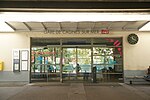Loup (river)
Climbing areas of FranceCoastal basins of the Mediterranean Sea in FrancePages including recorded pronunciationsPages with French IPARivers of Alpes-Maritimes ... and 2 more
Rivers of FranceRivers of Provence-Alpes-Côte d'Azur

The Loup (French pronunciation: [lu] ; Occitan: Lop) is a river in the Alpes-Maritimes department, Southeastern France. With a length of 49 kilometres (30 mi), it ends in the Mediterranean Sea in Villeneuve-Loubet, near Cagnes-sur-Mer. It takes its source in Andon.
Excerpt from the Wikipedia article Loup (river) (License: CC BY-SA 3.0, Authors, Images).Loup (river)
Promenade de l'Hippodrome, Grasse
Geographical coordinates (GPS) Address Nearby Places Show on map
Geographical coordinates (GPS)
| Latitude | Longitude |
|---|---|
| N 43.643055555556 ° | E 7.1447222222222 ° |
Address
Promenade de l'Hippodrome
06800 Grasse
Provence-Alpes-Côte d'Azur, France
Open on Google Maps








